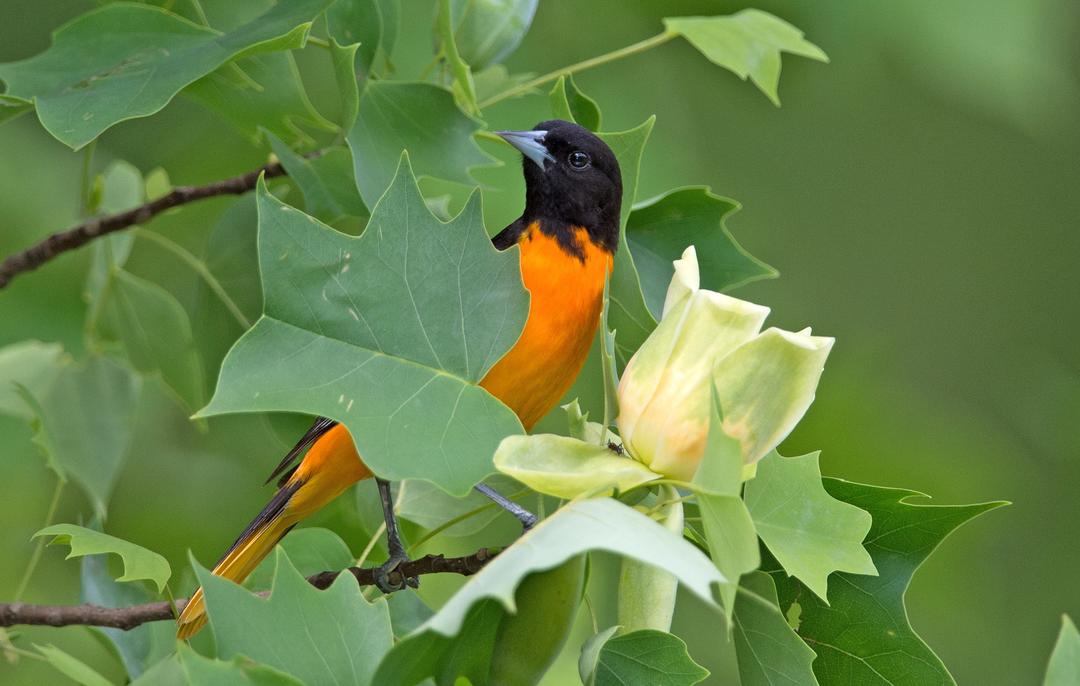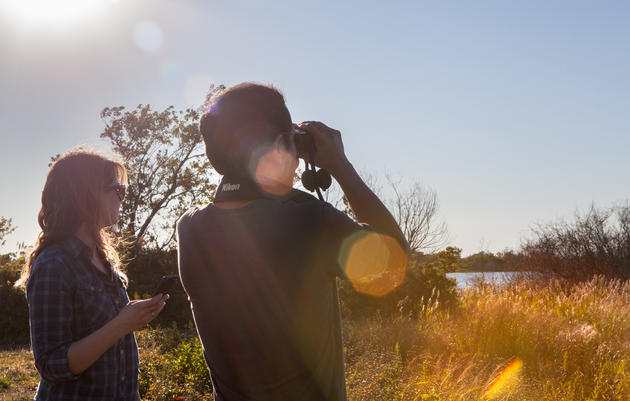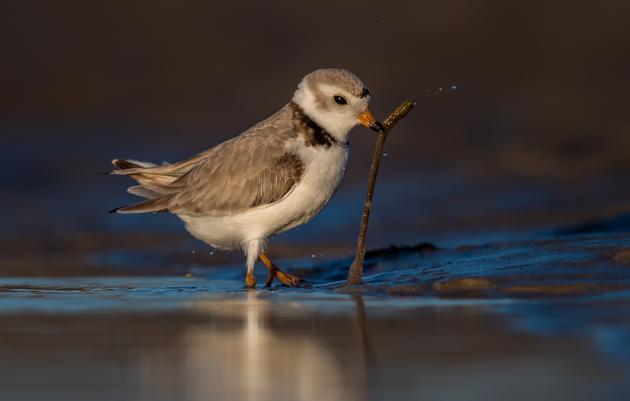Spring is in the air! Buds are blooming, birds are singing... maybe you're hearing some bird songs that are not so familiar. That likely means that you're noticing the return of spring migrants!
Below, we’ve compiled some of the most frequently asked questions having to do with migratory birds, their journeys, and ways we can welcome them back.
- Do all birds migrate?
No, some are permanent residents that have adapted to survive the cold winter months. But most of our birds do migrate, some further than others. While some might only migrate a few hundred miles to escape the worst of winter weather and food shortage, others migrate to use from as far as southern South America and back every year!
- How many miles do birds migrate?
The distance migratory birds will travel varies by species. Hummingbirds, the smallest migrant, can travel non-stop as far as 600 miles—which is quite a long journey for such a tiny bird! The Blackpoll Warbler is not much larger than a Black-capped Chickadee, but is able to fly 2,300 miles nonstop for 3-4 days to reach the higher elevations of the Adirondacks where it nests.
One of the most impressive migrants is the Arctic Tern. Each year they fly more than 49,000 miles round-trip—roughly equivalent to flying twice around the globe! They travel between breeding grounds in the Arctic and winter foraging areas in the waters off Antarctica.
- Why would birds leave the tropics, where it is warm year-round, to come here?!
Birds coming to us from the tropics are returning to their breeding grounds, where the days are longer and there is a greater abundance of food and space. Breeding in the heat of the tropics brings a different set of challenges to the success of the eggs and chicks. By migrating north, these species are moving to a more temperate climate to raise their delicate chicks.
By moving north, these birds “beat the competition” and have their pick from more habitat, which helps to avoid predators in some cases. Species can also remain healthier by dispersing to reduce the spreading of disease.
- Why do some birds migrate at night versus during the day?
Most songbirds migrate at night because the air is cooler (think about how hot you get running), allowing them to fly farther without having to stop and cool down. The air also tends to be more stable to make their flight easier, and there are far less predators able to catch them when flying at night.
- Do any birds migrate east to west?
In North America migration is typically north-south, but there may be segments that are east- west. Most birds will avoid flying over water if possible. For example, in the fall, birds in Connecticut will head south until they reach the southern coast of New England, then fly west until they reach NYC and continue south. This is best observed at Lighthouse Point Park in New Haven each fall. There you can watch hawks, blackbirds, kingbirds, and others all circling over the park to change direction to follow the coastline North along New Haven Harbor rather than continuing west over Long Island Sound and the widest part of the harbor.
In the spring, sea ducks, especially scoters and gannets, will fly west-east along Long Island and Connecticut coastlines.
- Why do birds migrate in flocks?
Birds will flock together because there is safety in their numbers. The larger the group, the more disorienting it can be for a predator like a Peregrine Falcon to focus on one individual bird. When they have landed, they can take turns watching for predators, so some can focus on eating or sleeping while others are on watch.
For birds flying in formation (like geese and cormorants), there is an interesting aerodynamic benefit to flying in a “V” formation. When positioned properly and flapping in sync, the birds save energy during flight.
- How do birds know when it’s time for them to migrate? Does a milder winter mean earlier arrival of migratory species?
Some birds are more flexible than others when it comes to the timing of their departure. There are many birds that are hardwired when to head north. Birds that are traveling from as far as South America or Costa Rica have no way of knowing what the weather is like in the United States, so a milder winter here will have no way of effecting their arrival.
The more flexible species are those that winter here in the US and have a shorter distance to travel to their breeding grounds. They may sense the milder temperatures and opt to head north sooner. This includes species like the Red-winged Blackbird, American Woodcock, and Tree Swallow.
Click here to read more about how different spring migrants decide when to head north.
-
You may leave food out for seed-eating birds, provide nectar for hummingbirds, or sliced oranges for orioles. Check out the Audubon Guide to Feeding Birds, here.
8. Should I provide food for migrating birds?
A more sustainable way of providing a food source for your backyard birds is by planting native plants! Many migratory songbirds eat insects, so planting native plants that host a great number and variety of native insects (as opposed to non-native plants), is another way you can "feed" birds. Many native plants will also produce fruit and other sources of food at the times that birds need it most. Find native plants for your region using Audubon’s Native Plants Database.
- What are other ways to help migrants along their journey?
Migration is no easy feat. It is treacherous and birds face many hazards along the way, but there are ways we can help! It is estimated that up to 1 billion birds die each year from window collisions. At home, we can make our windows more easily visible and therefore avoidable for birds in flight. Get creative with this DIY and create decals for your windows at home. If arts and crafts aren’t your thing, you can opt to order decals online, or look into more subtle ways to make your windows bird-friendly, like with Acopian BirdSavers.
- How can I experience spring migration firsthand? Where do I go to look for the birds?
Migration can be spellbinding to observe in hotspots like Central Park in New York City or East Rock Park in New Haven, Connecticut but it can be just as rewarding to get out in your own neighborhood and see who you can find! To start out birding on your own, it’s helpful to look where there are food sources—areas with diverse habitat, flowering trees (varied in height), insects, and water.
Along with strengthening your bird ID skills (we recommend the Audubon Bird Guide App), another way to take your birding experience to the next level is by learning to “bird by ear.” If you’re up for the challenge, click here to get started.













